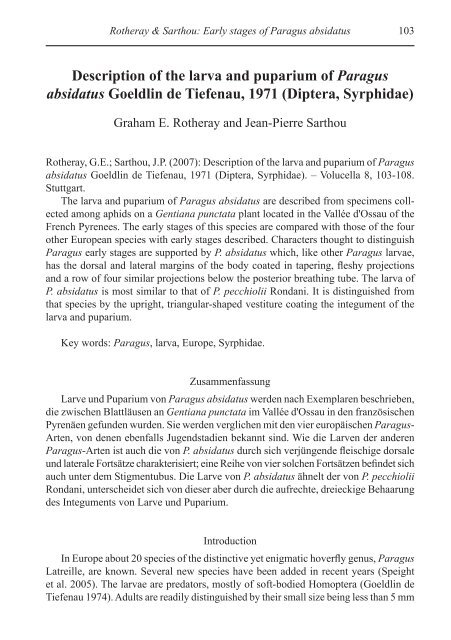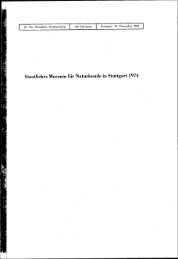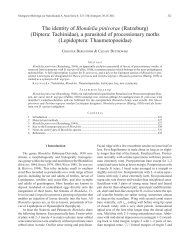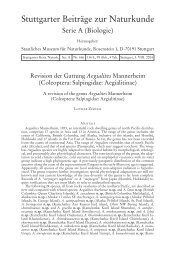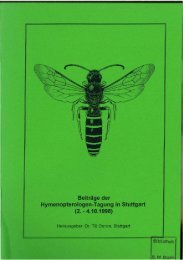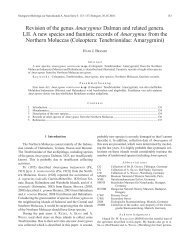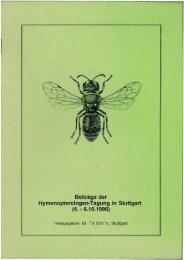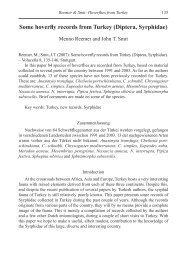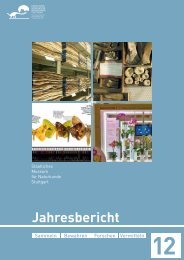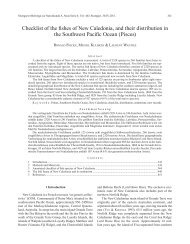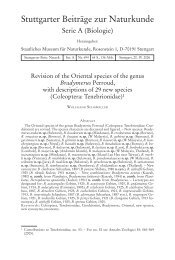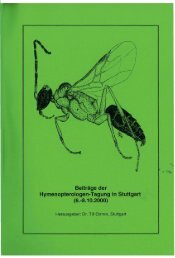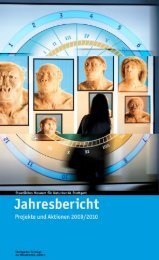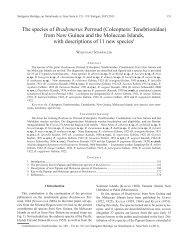Description of the larva and puparium of Paragus absidatus Goeldlin ...
Description of the larva and puparium of Paragus absidatus Goeldlin ...
Description of the larva and puparium of Paragus absidatus Goeldlin ...
- No tags were found...
Create successful ePaper yourself
Turn your PDF publications into a flip-book with our unique Google optimized e-Paper software.
Ro<strong>the</strong>ray & Sarthou: Early stages <strong>of</strong> <strong>Paragus</strong> <strong>absidatus</strong>103<strong>Description</strong> <strong>of</strong> <strong>the</strong> <strong>larva</strong> <strong>and</strong> <strong>puparium</strong> <strong>of</strong> <strong>Paragus</strong><strong>absidatus</strong> <strong>Goeldlin</strong> de Tiefenau, 1971 (Diptera, Syrphidae)Graham E. Ro<strong>the</strong>ray <strong>and</strong> Jean-Pierre SarthouRo<strong>the</strong>ray, G.E.; Sarthou, J.P. (2007): <strong>Description</strong> <strong>of</strong> <strong>the</strong> <strong>larva</strong> <strong>and</strong> <strong>puparium</strong> <strong>of</strong> <strong>Paragus</strong><strong>absidatus</strong> <strong>Goeldlin</strong> de Tiefenau, 1971 (Diptera, Syrphidae). – Volucella 8, 103-108.Stuttgart.The <strong>larva</strong> <strong>and</strong> <strong>puparium</strong> <strong>of</strong> <strong>Paragus</strong> <strong>absidatus</strong> are described from specimens collectedamong aphids on a Gentiana punctata plant located in <strong>the</strong> Vallée d'Ossau <strong>of</strong> <strong>the</strong>French Pyrenees. The early stages <strong>of</strong> this species are compared with those <strong>of</strong> <strong>the</strong> fouro<strong>the</strong>r European species with early stages described. Characters thought to distinguish<strong>Paragus</strong> early stages are supported by P. <strong>absidatus</strong> which, like o<strong>the</strong>r <strong>Paragus</strong> <strong>larva</strong>e,has <strong>the</strong> dorsal <strong>and</strong> lateral margins <strong>of</strong> <strong>the</strong> body coated in tapering, fleshy projections<strong>and</strong> a row <strong>of</strong> four similar projections below <strong>the</strong> posterior breathing tube. The <strong>larva</strong> <strong>of</strong>P. <strong>absidatus</strong> is most similar to that <strong>of</strong> P. pecchiolii Rondani. It is distinguished fromthat species by <strong>the</strong> upright, triangular-shaped vestiture coating <strong>the</strong> integument <strong>of</strong> <strong>the</strong><strong>larva</strong> <strong>and</strong> <strong>puparium</strong>.Key words: <strong>Paragus</strong>, <strong>larva</strong>, Europe, Syrphidae.ZusammenfassungLarve und Puparium von <strong>Paragus</strong> <strong>absidatus</strong> werden nach Exemplaren beschrieben,die zwischen Blattläusen an Gentiana punctata im Vallée d'Ossau in den französischenPyrenäen gefunden wurden. Sie werden verglichen mit den vier europäischen <strong>Paragus</strong>-Arten, von denen ebenfalls Jugendstadien bekannt sind. Wie die Larven der <strong>and</strong>eren<strong>Paragus</strong>-Arten ist auch die von P. <strong>absidatus</strong> durch sich verjüngende fleischige dorsaleund laterale Fortsätze charakterisiert; eine Reihe von vier solchen Fortsätzen befindet sichauch unter dem Stigmentubus. Die Larve von P. <strong>absidatus</strong> ähnelt der von P. pecchioliiRondani, unterscheidet sich von dieser aber durch die aufrechte, dreieckige Behaarungdes Integuments von Larve und Puparium.IntroductionIn Europe about 20 species <strong>of</strong> <strong>the</strong> distinctive yet enigmatic hoverfly genus, <strong>Paragus</strong>Latreille, are known. Several new species have been added in recent years (Speightet al. 2005). The <strong>larva</strong>e are predators, mostly <strong>of</strong> s<strong>of</strong>t-bodied Homoptera (<strong>Goeldlin</strong> deTiefenau 1974). Adults are readily distinguished by <strong>the</strong>ir small size being less than 5 mm
Ro<strong>the</strong>ray & Sarthou: Early stages <strong>of</strong> <strong>Paragus</strong> <strong>absidatus</strong>107Comparing <strong>larva</strong>l <strong>and</strong> puparial descriptions <strong>and</strong> figures <strong>of</strong> P. albifrons, haemorrhous,pecchiolii <strong>and</strong> quadrifasciatus in <strong>Goeldlin</strong> de Tiefenau (1974) with <strong>the</strong> <strong>larva</strong> <strong>and</strong> <strong>puparium</strong><strong>of</strong> P. <strong>absidatus</strong> studied here, <strong>the</strong> early stages <strong>of</strong> <strong>the</strong> latter species are most similar toP. pecchiolii. Both species have <strong>the</strong> projection bearing sensilla 2 on abdominal segments1-7 about as equally long as that bearing sensilla 1 <strong>and</strong> <strong>the</strong> projections bearing sensilla1 on <strong>the</strong> seventh abdominal segment are so approximated that <strong>the</strong>ir bases are touching.Nei<strong>the</strong>r <strong>of</strong> <strong>the</strong>se characters appear to be present in <strong>the</strong> early stages <strong>of</strong> o<strong>the</strong>r <strong>Paragus</strong>species in which <strong>the</strong> projection bearing sensilla 2 is usually shorter than those bearingsensilla 1 <strong>and</strong> <strong>the</strong> projections bearing sensilla 1 on <strong>the</strong> seventh abdominal segment areseparate.The early stages <strong>of</strong> P. <strong>absidatus</strong> appear to be distinguished from those <strong>of</strong> P. pecchioliiby <strong>the</strong> vestiture. The vestiture <strong>of</strong> P. <strong>absidatus</strong> is relatively large <strong>and</strong> conspicuousconsisting <strong>of</strong> upright, triangular-shaped setae whereas that <strong>of</strong> P. pecchiolii appears toconsist <strong>of</strong> inconspicuous nodules (<strong>Goeldlin</strong> 1974).The functional significance <strong>of</strong> similarities <strong>and</strong> differences in <strong>the</strong> states <strong>of</strong> dorsalprojections <strong>and</strong> vestiture in <strong>Paragus</strong> <strong>larva</strong>e are difficult to assess. However, if <strong>the</strong>y arefunctional, <strong>the</strong>y are most likely to have been affected by crypsis (Ro<strong>the</strong>ray 1986). Itis possible that crypsis against background features <strong>of</strong> aphid host plants may explaindifferences observed between <strong>Paragus</strong> <strong>larva</strong>e.ReferencesDixon, T.J. (1960): Key to <strong>and</strong> descriptions <strong>of</strong> <strong>the</strong> third instar <strong>larva</strong>e <strong>of</strong> some species <strong>of</strong> Syrphidae (Diptera)occurring in Britain. – Transactions <strong>of</strong> <strong>the</strong> Royal Entomological Society <strong>of</strong> London 112, 345-379.<strong>Goeldlin</strong> de Tiefenau, P. (1974): Contribution a l'étude systématique et écologique des Syrphidae (Dipt.) dela Suisse occidentale. – Mitteilungen der Schweizerischen Entomologischen Gesellschaft 47, 151-252.<strong>Goeldlin</strong> de Tiefenau P. (1976): Révision du genre <strong>Paragus</strong> (Dipt., Syrphidae) de la région paléarctiqueoccidentale. – Mitteilungen der Schweizerischen Entomologischen Gesellschaft 49, 79-108.Hartley J.C. (1963): The cephalopharyngeal apparatus <strong>of</strong> syrphid <strong>larva</strong>e <strong>and</strong> its relationship to o<strong>the</strong>r Diptera.– Proceedings <strong>of</strong> <strong>the</strong> Zoological Society <strong>of</strong> London 141, 261-280.Marcos-Garcia, M.A. (1986): Citas de interes del genero <strong>Paragus</strong> Latreille, 1804 en la Peninsula Iberica ydescripcion de <strong>Paragus</strong> v<strong>and</strong>ergooti sp.nov. (Diptera, Syrphidae). – Actas de las VIII Jornadas A e E,765-772.Marcos-Garcia, M.A.; Rojo, S. (1994): <strong>Paragus</strong> hyalopteri n.sp. an aphidophagous hoverfly (Dipt.: Syrphidae)attacking <strong>the</strong> mealy plum aphid (Hom: Aphididae). – Entomophaga 39, 99-106.Ro<strong>the</strong>ray, G.E. (1986): Colour, shape <strong>and</strong> defence in aphidophagous syrphid <strong>larva</strong>e (Diptera). – ZoologicalJournal <strong>of</strong> <strong>the</strong> Linnean Society 88, 201-216.Ro<strong>the</strong>ray, G.E. (1993): Colour Guide to Hoverfly Larvae (Diptera, Syrphidae). – Dipterists Digest No. 9,1-156.Ro<strong>the</strong>ray, G.E.; Gilbert, F.S. (1989): The phylogeny <strong>and</strong> systematics <strong>of</strong> European predacious Syrphidae(Diptera) based on <strong>larva</strong>l <strong>and</strong> puparial stages. – Zoological Journal <strong>of</strong> <strong>the</strong> Linnean Society 95, 29-70.Ro<strong>the</strong>ray, G.E.; Gilbert, F.S. (1999): Phylogeny <strong>of</strong> Palaearctic Syrphidae (Diptera): Evidence from <strong>larva</strong>lstages. – Zoological Journal <strong>of</strong> <strong>the</strong> Linnean Society 127, 1-112.Sommaggio D. (2002): <strong>Paragus</strong> gorgus Vujić & Radenković, 1999: a junior synonym <strong>of</strong> P. majoranae Rondani,1857, <strong>and</strong> reinstatement <strong>of</strong> P. pecchiolii Rondani, 1857 (Diptera, Syrphidae) – Volucella 6, 53-56.Speight, M.C.D.; Castella, E.; Sarthou, J.P.; Monteil, C. (2006): Syrph <strong>the</strong> Net on CD. Issue 5. The database<strong>of</strong> European Syrphidae. Dublin (Syrph <strong>the</strong> Net Publications).
108Volucella 8, 2007Addresses <strong>of</strong> authors:Graham E Ro<strong>the</strong>ray, National Museums <strong>of</strong> Scotl<strong>and</strong>, Chambers Street, Edinburgh EH11JF UK. E-mail: g.ro<strong>the</strong>ray@nms.ac.ukJean-Pierre Sarthou, UMR Dynafor, INP-ENSAT, BP 32607, 31326 Auzeville-Tolosanecedex, France. E-mail: sarthou@ensat.fr


